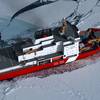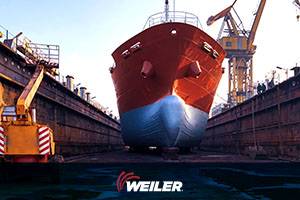In tying its eight diverse facilities together with a state-of-the-art information system, Bollinger Shipyards plans to recoup monetary and efficiency rewards far exceeding the $2.5 million investment.
Bollinger Shipyards has aggressively pursued a course of expansion of physical facilities over the past few years, though not to the point of over-extension whereby down markets would cause a serious financial crisis.
But while the shipyard has steadily added to its capabilities, it realized that expansion of facilities without a thorough revamp of its own internal communications and processes would be foolhardy, as well as very costly.
Enter Arthur Andersen and Oracle.
To facilitate its strategy to align its management and resources along lines of business as opposed to geography, the company employed the services of one of the country's premier management consultancies and the products and services of one of the world's leading software system manufacturers. With the idea of taking a more centralized view of providing services, management and support to all of the company's businesses without jeopardizing the entrepreneurial spirit of local manager, the company set out to connect all of its locations via a T-1 based Wide Area Netwok (WAN) and then implement an Enterprise Resource Planning System (ERP). An ERP is lingo for a system that uses one database and several software application modules to automate all of a company's key operational and financial processes.
Pruning the Bollinger tree
Bollinger Shipyards has 1,800 employees and is comprised of eight shipyards spread throughout Southern Louisiana, with 120 miles being the furthest distance between two of its facilities. The company collectively processes about 35,000 tons of steel, churning out approximately 120 boats and barges in a given year.
Until recently, the company's shipyards were using several different software/systems to produce financial/operational information necessary to run the business. In addition, several manual processes and mechanisms were used in the estimating, scheduling, purchasing and accounting. In order to report of use information on a consolidated basis, countless manual hours had to be expended to pulling spreadsheets together from several different softwares and databases. In essence, the company spent more time producing the information than it did analyzing it.
Several attempts had been made in the past to select and implement an enterprise wide software that would facilitate the functionality required by not just the new construction of vessels, but also the repair and conversion of vessels. However, those attempts have not been successful due to software limitation and the inability for the company to perform the necessary changes required to implement such a system.
Prior to the purchase of Oracle ERP applications software, the company embarked on an extensive selection process designed to match the company's needs and requirements for a comprehensive system to the functionality of individual ERP systems. Due to the time constraints involved in implementing an ERP package prior to the company's Y2K deadlines, the company hired Arthur Andersen LLP as an outside consultant to assist in the selection and implementation process. In gathering input for the final selection process, Bollinger gave every functional area the opportunity to prioritize their specific requirements of the new system.
The unique business environment of marine construction presents many and diverse informational needs, the collective industry in the U.S. is hardly large enough to garner cost effective, industry specific solutions. In evaluating the ERP packages, however, it became apparent that Oracle's product was best suited for Bollinger's needs. According to the company, no system was a 100 percent fit. But it noted that the Oracle system met its 80 percent matching goal.
Once the system was selected, the question of cost came next. And although the cost of implementing the Oracle system was steep at an estimated $2.5 million, Bollinger reasoned that the cost of not having the system was even greater. According to the company, the cost of implementing the system became much more justifiable when it was realized that there will be an anticipated annual savings (both direct and indirect) of between $750,000 and $1 million, with purchasing and material handling leading the pack at an estimated annual savings of $600,000 per year. Other anticipated savings include: administration and processing = $250k/yr.; inventory carrying cost = $100k/yr.; and "other" = $50k/yr.
The integrated solution
The full suite of products installed includes Manufacturing, Projects, Project Manufacturing, Purchasing, Inventory, HR/Payroll, Financials and MRP. All are designed to enable the company to have all of its information under one database/suite of products and shared throughout all of the divisions.
In addition, Oracle's software is browser based and designed to operate over the Internet, which will reduce maintenance costs of the system. All updates, upgrades, system changes, maintenance and end user changes are made locally on the centralized server.Once fully operational (at press time the company was still tweaking the system to its own specific needs) the efficiencies and cost savings will be numerous. The cost to produce and process P.O.'s, pick lists, requisitions, invoices, A/P checks, payroll, HR requests and other functions will decrease substantially. Project managers will have more accurate and timely information to make crucial real time decisions on the shop floor. Estimators will have more task level information and history to assist them in projecting the cost of building vessels. Schedulers and shop floor managers will have automated maps of material and manpower requirements, thus increasing labor efficiency. Inventory will be much more accurate and visible through the system. Purchasing will have the advantage of a master parts list encompassing all of the company's divisions. This will facilitate the company's centralized purchasing initiative and allow Bollinger to capitalize on the buying power of its combined divisions. All levels of management will have more accurate and detailed financial/operational information to assist in running the business as well as planning for the future.
Sponsored Content
Safer Starts Here: Build Ships, Protect Crews

July 2025
 Read the Magazine
Read the Magazine

 Read the Magazine
Read the Magazine
This issue sponsored by:

An Unclear Present Danger: The Future of Mine Warfare Is Deception
Subscribe for
Maritime Reporter E-News
Maritime Reporter E-News is the maritime industry's largest circulation and most authoritative ENews Service, delivered to your Email five times per week









